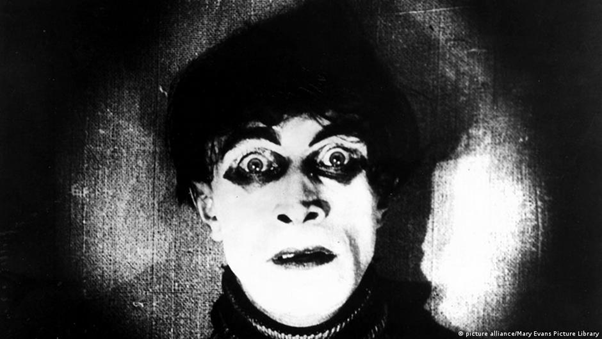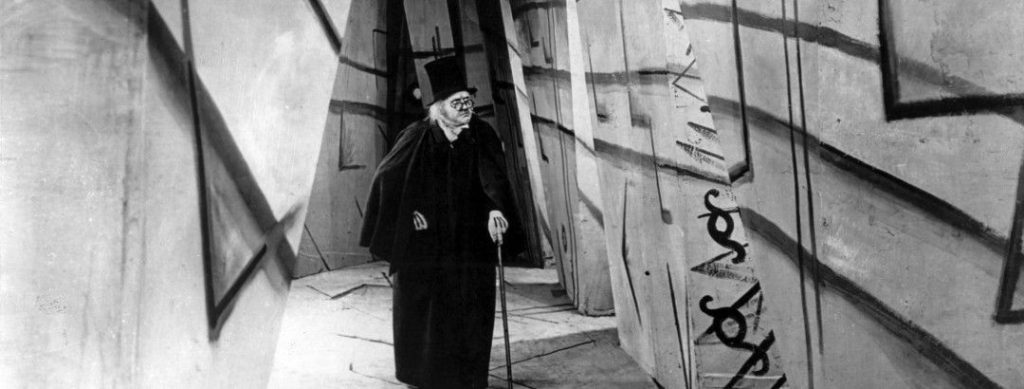
Playing improvised soundtracks over films is something I really enjoy. In September ’22, courtesy of Wales One World Film Festival and Llanwarne Village Hall, along with the wonderful Ashley John Long on Bass, we get to bounce off the world’s most famous German Expressionist silent film “The Cabinet of Dr Caligari”
If you don’t know the film here’s Wikipedia’s precis. “The Cabinet of Dr. Caligari (Das Cabinet des Dr. Caligari) is a 1920 German silent horror film. Directed by Robert Wiene and written by Hans Janowitz and Carl Mayer. It is considered the quintessential work of German Expressionist cinema. It tells the story of an insane hypnotist (Werner Krauss) who uses a somnambulist (Conrad Veidt) to commit murders. The film features a dark and twisted visual style, with sharp-pointed forms, oblique and curving lines, structures and landscapes that lean and twist in unusual angles, and shadows and streaks of light painted directly onto the sets … The script was inspired by various experiences from the lives of Janowitz and Mayer, both pacifists who were left distrustful of authority after their experiences with the military during World War 1″.
The marriage of German Expressionism and European Free Form Music
I’ve played improvised soundtracks several times and have mentioned it in other posts (Latitude Festival and the Heywood Gallery 24). It strikes me that German Expressionist Cinema is superbly suited to the our freer approach to music than most other forms. I guess this is partly due to the genre’s environment; being low budget (to start with) the sets were wildly non-realistic, distorted shapes, often exaggerated to create a sense of the other. They often dealt with themes of disturbance such as madness and betrayal, triggered by the experiences of the Great War. The style was a direct reaction against the romantic and action adventures of the time. This provided a platform for experimentation, embracing bold new ideas and artistic styles. Free form music parallels these ideas as it removes itself from the confines of straight ahead more formal genres and provides that scary blank canvas.

I’m reminded of Richard Branson’s purchase of the rights to Fritz Lang‘s masterpiece, Metropolis (1927). It was reissued with a soft rock soundtrack. It didn’t work for me as it wasn’t responsive and did nothing to enhance the progress of the plot. Personally I thought it a travesty and missed completely the point of the art of good soundtrack writing (sometimes popular music works if used well – Pulp Fiction for example).
Literally?
What I do firmly understand is that the visual input is a great alternative score. I’ve mentioned this is a previous post ”arwyddion ffyrdd Cymru/Welsh Road signs“. I believe its a means of access and enlightenment for those who have never heard such extremes of music. “Imagine what you’re about to hear is the soundtrack to a film – but you have to make the film up in your imagination”. When there’s a film playing then the task is somewhat easier. From the player’s perspective there is a temptation to interpret things literally, which does very little in this context. Playing an ascending scale when someone walks up the stairs is superfluous. The visual tells you someone’s walking up the stairs (it works for Tom and Jerry films though).
What we are really after is capturing the emotion of the moment. Expressing how we feel about it, reacting to how the audience feels about it and then becoming collectively nourished.

A big thanks to Clive and Lynda from Eclectic Films for organising this. Also the support from Herefordshire Council and Community First
Here’s a few videos of the performance ranging through a variety of emotions and instruments: